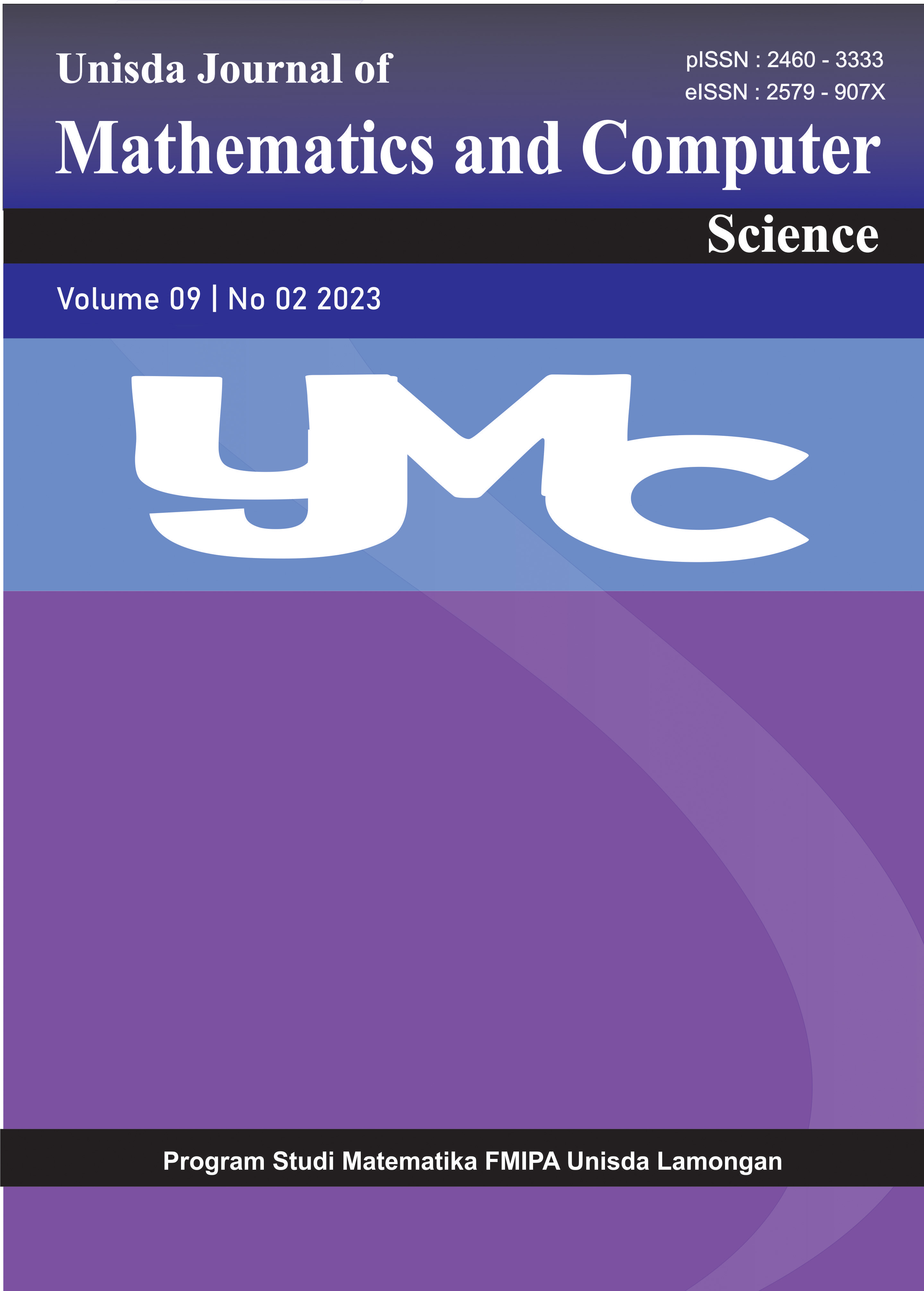Analisis Multiple Alignment Pada Penyebaran Epidemi Sars Cov E.G 5.1 Menggunakan Metode Neighbor - Joining
Abstract
SARS CoV-2 merupakan suatu virus yang masih menjadi topik hangat di media dan sangat menarik untuk dikaji. Apalagi SARS CoV-2 semakin bermutasi dari waktu ke waktu dan memunculkan varian jenis baru. Akhir-akhir ini dunia kembali dihebohkan dengan munculnya varian SARS CoV-2 jenis baru yang bernama varian E.G 5.1 atau biasa disebut Eris. Di Indonesia, varian E.G 5.1 pertama kali dilaporkan di Provinsi Jakarta pada 09/03/2023. Berdasarkan hal tersebut, penulis ingin mengetahui proses penyebaran Epidemi SARS CoV E.G 5.1 yang terjadi di Indonesia dengan analisis Multiple Alignment. Analisis ini memiliki beberapa tahap antara lain, melakukan analisis sistem jaringan topologi, sistem jaringan daerah mutasi dan sistem jaringan mode mutasi, sehingga diperoleh pohon filogenetik menggunakan algoritma Neighbor-Joining yang digunakan untuk menentukan awal mula penyebaran virus. Data yang digunakan adalah data 92 sekuen DNA yang diperoleh melalui GISAID. Hasil dari analisis tersebut diperoleh awal mula penyebaran SARS CoV E.G 5.1 di Indonesia yang secara singkat berawal dari Jakarta 09/03/2023, kemudian menyebar ke Bogor 20/04/23, Medan 11/05/23, Surabaya 03/07/23, Bandung 24/10/23, Riau 07/12/23, dan terakhir menyebar di Provinsi Bali (Denpasar) pada tanggal 10/12/23 dan 11/12/23.
References
[2] S. Gaffar, S. A. F. Rahmani, and A. Hardianto, “Mutation and Phylogenetic Analysis of Spike Glycoprotein of Indonesian Isolates of Severe-Acute-Respiratory-Syndrome-Coronavirus-2 (SARS-CoV-2),” Maj. Kedokt. Bandung, vol. 53, no. 1, 2021, doi: 10.15395/mkb.v53n1.2230.
[3] A. M. ; Rohmah and D. Rahmalia, “SEIR model simulation on the spreading of Ebola virus between two regions,” J. Phys. Conf. Ser., vol. 1, 2021.
[4] A. M. Rohmah and D. Rahmalia, “Penyelesaian positif model penyebaran virus ebola antar dua wilayah,” J. Mat. Univ. Udayana, vol. 2, no. 10, pp. 44–52, 2020.
[5] A. Susilo et al., “Mutasi dan Varian Coronavirus Disease 2019 (COVID-19): Tinjauan Literatur Terkini,” J. Penyakit Dalam Indones., vol. 9, no. 1, p. 59, 2022, doi: 10.7454/jpdi.v9i1.648.
[6] R. Bestari et al., “SARS-CoV-2 lineages circulating during the first wave of the pandemic in North Sumatra, Indonesia,” IJID Reg., vol. 8, no. July, pp. S1–S7, 2023, doi: 10.1016/j.ijregi.2023.07.006.
[7] S. U. Firdaus, J. Wiwoho, and M. A. Hidayat, “The Effectiveness of the Implementation of Occupational Health and Safety (OHS) in Indonesian Medical Personnel During the Covid-19,” UNIFIKASI J. Ilmu Huk., vol. 10, no. 2, pp. 74–87, 2023, doi: 10.25134/unifikasi.v10i2.7938.
[8] A. Girma, “The Many Mutations of the COVID-19 Variant: Current Perspectives on EG.5/Eris,” Environ. Health Insights, vol. 17, pp. 0–4, 2023, doi: 10.1177/11786302231217805.
[9] A. E. E. D. Rashed, H. M. Amer, M. El-Seddek, and H. E. D. Moustafa, “Sequence Alignment Using Machine Learning-Based Needleman-Wunsch Algorithm,” IEEE Access, vol. 9, pp. 109522–109535, 2021, doi: 10.1109/ACCESS.2021.3100408.
[10] M. S. Pradana and S. Amiroch, “Protein sequence analysis of the Zika virus and the dengue virus using Smith Waterman algorithm,” AIP Conf. Proc., vol. 2084, no. March, 2019, doi: 10.1063/1.5094275.
[11] S. Amiroch, M. S. Pradana, M. I. Irawan, and I. Mukhlash, “Multiple alignment analysis on phylogenetic tree of the spread of SARS epidemic using distance method,” J. Phys. Conf. Ser., vol. 890, no. 1, 2017, doi: 10.1088/1742-6596/890/1/012080.
[12] S. Amiroch, M. I. Irawan, I. Mukhlash, A. Nur, M. Ansori, and A. Nidom, “Identification of the Spread of the Influenza Virus Type A / H9N2 in Indonesia Using the Neighbor-Joining Algorithm with Felsenstein Models 使用费尔森施泰因模型的邻居加入算法识别印度尼西亚一种 / 我们的权利型流感病 毒的传播,” 2021.
[13] S. Amiroch and A. Rohmatullah, “Determining geographical spread pattern of MERS-CoV by distance method using Kimura model,” AIP Conf. Proc., vol. 1825, no. Symomath, pp. 1–8, 2017, doi: 10.1063/1.4978970.
[14] M. I. Irawan and I. Mukhlash, “Maximum Likelihood Method on The Construction of Phylogenetic Tree for Identification the Spreading of SARS Epidemic,” no. 1, pp. 137–141, 2018.
[15] S. Amiroch, M. S. Pradana, M. I. Irawan, and I. Mukhlash, “A Simple Genetic Algorithm for Optimizing Multiple Sequence Alignment on the Spread of the SARS Epidemic,” Open Bioinforma. J., vol. 12, no. 1, pp. 30–39, 2019, doi: 10.2174/1875036201912010030.

This work is licensed under a Creative Commons Attribution-ShareAlike 4.0 International License.
Authors who publish in UJMC (Unisda Journal of Mathematics and Computer Science) agree to the following terms:
1.Authors retain copyright and grant the journal right of first publication with the work simultaneously licensed under a Creative Commons Attribution License (CC BY-SA 4.0) that allows others to share the work with an acknowledgment of the work's authorship and initial publication in this journal.
2.Authors are able to enter into separate, additional contractual arrangements for the non-exclusive distribution of the journal's published version of the work (e.g., post it to an institutional repository or publish it in a book), with an acknowledgment of its initial publication in this journal.
3.Authors are permitted and encouraged to post their work online (e.g., in institutional repositories or on their website) prior to and during the submission process, as it can lead to productive exchanges, as well as earlier and greater citation of published work.









